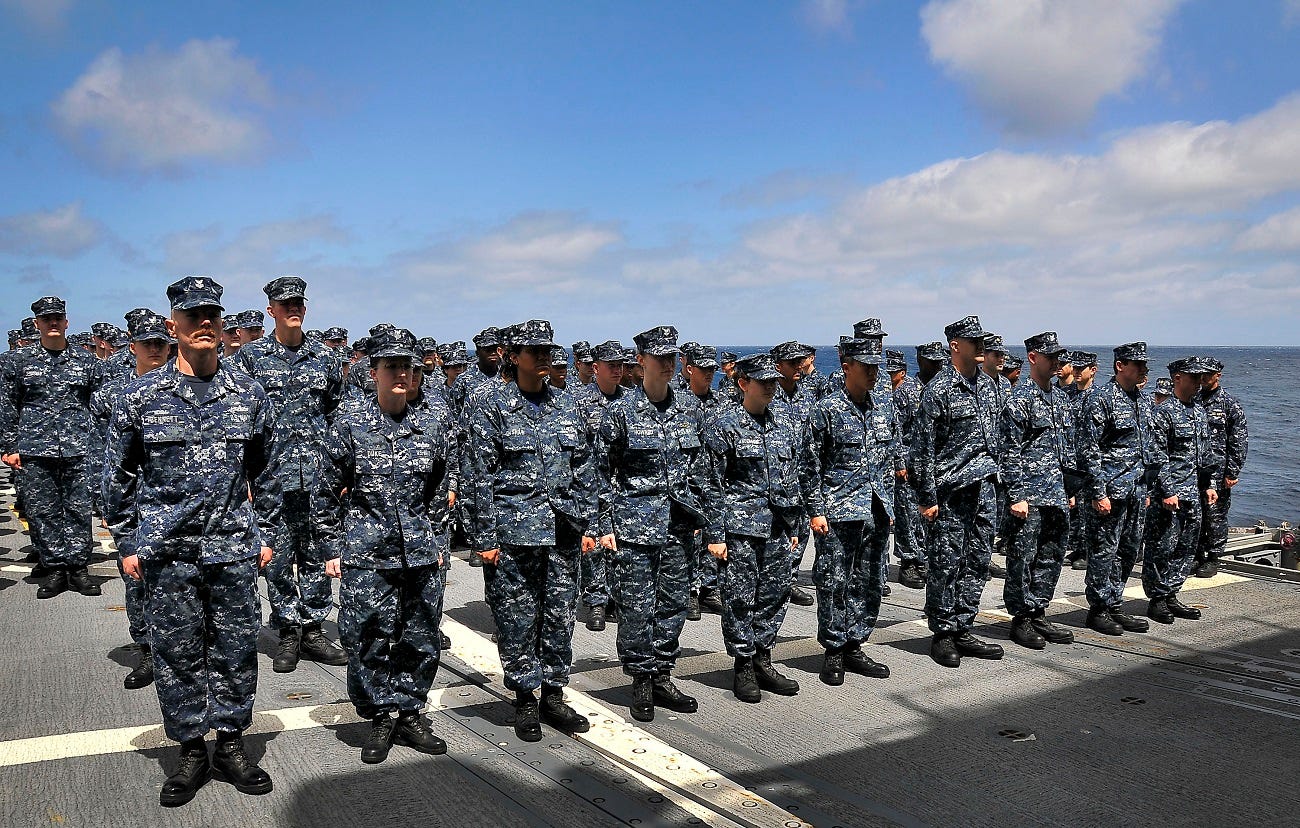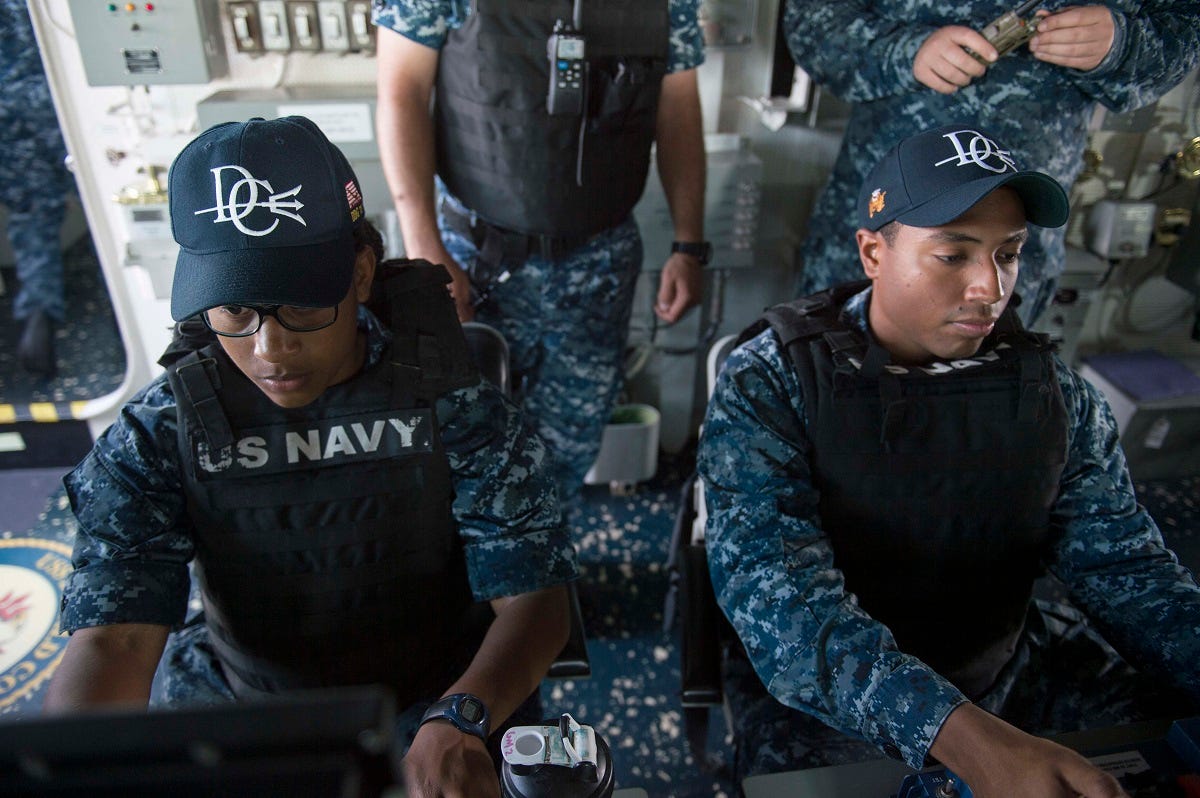by ROBERT BECKHUSEN
Sailors stand at attention aboard the cruiser USS ‘Bunker Hill.’ U.S. Navy photo
 The U.S. Navy’s blue-and-gray camouflage working uniforms have been something of a joke since they were introduced in 2009. The most common one being that they serve to conceal sailors in the water after falling overboard.
The U.S. Navy’s blue-and-gray camouflage working uniforms have been something of a joke since they were introduced in 2009. The most common one being that they serve to conceal sailors in the water after falling overboard.
The career of the Navy Working Uniform Type I — as they are officially called — will also be short lived. On Aug. 4, the Navy announced it is phasing out the uniforms completely by Oct. 1, 2019.
In their place, the Navy will adopt woodland-pattern cammies known as Type IIIs, which are currently worn by specialized units including sailors serving in tactical roles. “[Sailors] want uniforms that are comfortable, lightweight, breathable … and they want fewer of them,”
The feedback on the “blueberries” has been divisive. Some sailors liked the blue uniforms for their distinctiveness from the Army, Air Force and Marines. But this was far from universal.
“They were terrible uniforms, overpriced and uncomfortable and even less enduring than the crappy utilities they replaced,” one commenter reacted on the Navy’s Facebook page after the announcement.
 Sailors aboard the destroyer USS ‘Donald Cook.’ U.S. Navy photo
Sailors aboard the destroyer USS ‘Donald Cook.’ U.S. Navy photo
Senior officials have openly mocked the uniform.
“The Navy ‘blueberries’ — I don’t know what the name is, that’s what sailors call them — the great camouflage it gives is if you fall overboard,” Mabus said in 2013. “The notion that we [have] all [this] camouflage doesn’t make a lot of sense to me.”
Sailors generally wear fireproof coveralls when at sea, but the Navy wants to replace these as well, because they’re too stiff and heavy. Meanwhile, the “working” blue cammies worn mainly ashore are highly flammable as they contain nylon — and worse, turn into melted goo when burned.
But if the uniforms were so impractical, why did the Navy adopt them, anyways?
Simple. Practicality and rationality (although the cammies help hide stains) rarely apply when it comes to fashion.
Clothing is a matter of self-expression. That’s true for the military just as it is for the civilian world. While militaries are centuries removed from the outrageous, Liberace-style tights of the Napoleonic era, armies and navies still like to strut.
And that’s true for, well, most of us. Nothing about how we dress makes a whole lot of logical sense. There is also a recent history of uniform changes across the military that plays an important role in how the blueberries came to be.
In the 1990s, U.S. troops mainly wore standard woodland and desert camo uniforms across the armed services. Soldiers, airmen and Marines looked similar. The Navy wore (highly flammable) dungarees that had barely changed since 1913 before switching to a widely-hated “utilities” uniform.
However, following the 9/11 attacks, the Marine Corps introduced a distinct pattern known as MARPAT. While being a good-looking and highly concealable pattern, it is Marine-only — as the Marines covet appearing distinct from the other branches.
At the same time, rising defense expenditures freed up money to design and adopt the new style.
In 2005, the Army followed suit with the Army Combat Uniform — which until 2015 sported one of the most hideous camouflage patterns in U.S. military history, and which also failed to provide concealment. Not to be left out, the Air Force adopted a distinct uniform in 2011 derived from Vietnam War-era “Tigerstripe.”
And in 2009, the Navy adopted the blueberry. All told, the U.S. military has spent billions — $5 billion for the Army’s ACU alone — in the past decade and a half developing and fielding new uniforms.
Now the Navy is swapping out its blues for greens. Or “guacs” as the Type IIIs are known because of their guacamole-lookingpattern. “Our force really lovesthe Type III’s,” Vice Adm. Robert P. Burke told the Navy Times.
“Fleet feedback is that it’s lighter, it breathes good in hot weather climate, it’s got the right accessories for cold weather climates — and it just wears better.”
And really, it doesn’t matter what color the Navy chooses. There’s not exactly much foliage around. The sailors are serving in ports and industrial facilities, or on large ships … in the water.
No comments:
Post a Comment